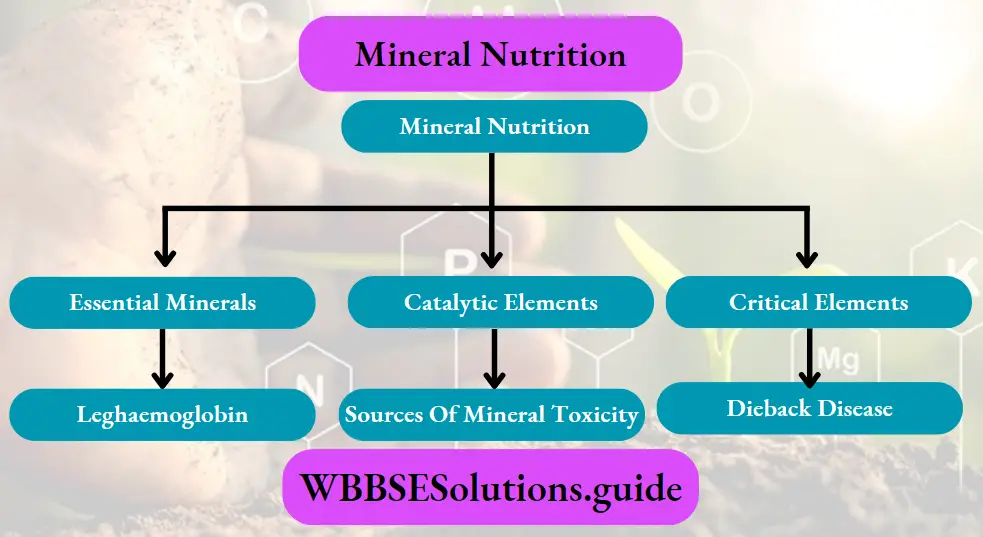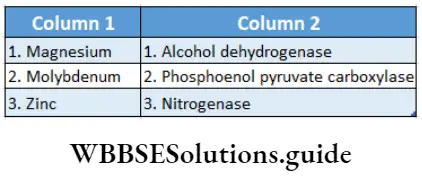Class 11 Biology WBCHSE Mineral Nutrition Questions And Answers
Question 1. How are the essential minerals classified according to their functions?
Answer: According to functions, the essential minerals are divided into four groups—
- Constituents of essential structural components, such as C, H, O, N.
- Constituents of energy-providing chemical components, such as Mg, P.
- Enzyme activators and inhibitors such as Mg, and Zn.
- Osmotic potential regulators such as K.

Question 2. What are catalytic elements?
Answer: The elements, which act as co-enzymes are known as catalytic elements. These elements, regulate the rate of biochemical reaction in which they are involved. For example, manganese acts as a coenzyme in the enzyme mangano-protein of PS II.
” nitrococcus”
Question 3. What are critical elements?
Answer: Nitrogen, phosphorus, and potassium are critical elements for plants as they are required in large amounts. In soil, these elements are often found in very small quantities but they are very essential for plant growth. So, these elements are provided to plants through fertilizers.
Read and Learn More WBCHSE Solutions For Class 11 Biology
Question 4. What is leghaemoglobin?
Answer: A dark pink-colored pigment, present in the root nodules of leguminous plants, is called leghaemoglobin. It is produced by the joint activity of bacteria and host cell cytoplasm. Due to its similarity with hemoglobin, it is named leghaemoglobin. It plays a key role in nitrogen fixation.
Question 5. Write the similarities and differences between hemoglobin and leghaemoglobin.
Answer:
Similarities:
- Leghaemoglobin and hemoglobin both act as oxygen carriers.
- Both are chemically and structurally similar. Hence, the color of the two pigments is almost the same.
Differences:
- Leghaemoglobin accepts and stores oxygen. This way it makes a suitable anaerobic environment for nitrogen fixation. However, hemoglobin transports oxygen during cellular respiration.
- Leghaemoglobin is formed due to the infection caused by the nitrogen-fixing bacteria, in the root nodules of leguminous plants. Haemoglobin is found in the red blood cells of the vertebrates naturally.
| Class 11 Biology | Class 11 Chemistry |
| Class 11 Chemistry | Class 11 Physics |
| Class 11 Biology MCQs | Class 11 Physics MCQs |
| Class 11 Biology | Class 11 Physics Notes |
Class 11 Biology WBCHSE
Question 6. What is solution culture?
Answer: The method of growing plants in a nutrient solution, in the absence of soil is known as solution culture. This is also known as hydroponics.

Question 7. What are the sources of mineral toxicity?
Answer:
The different sources of mineral toxicity are—
- Use of excess fertilizers in agriculture.
- The mineral components from factories and industries, mix with the soil and water.
- High concentration of any mineral in the soil.
Question 8. What is dieback disease?
Answer: This disease of plants is caused by the deficiency of Cu2+ and K+. In this disease, the apical bud is destroyed first followed by other parts of the plants.
Question 9. What are balancing elements?
Answer: The toxic effect of any mineral can be decreased by the application of certain elements. These elements are known as balancing elements. For example, K and Ca balance the toxic effect of heavy metals.
Question 10. What are diazotrophs?
Answer: The plants, that can bind atmospheric nitrogen in their body, are known as diazotrophs.
Question 11. What do you mean by biological nitrogen fixation?
Answer: The blue-green algae or cyanobacteria and some species of bacteria reduce atmospheric nitrogen to form ammonia by the enzyme nitrogenase. This process is known as biological nitrogen fixation.
Question 12. What is nodule meristem?
Answer: The meristematic tissues, involved in the nodule formation of leguminous plants, form the nodule meristem.
mineral nutrition neetprep
Class 11 Biology WBCHSE Mineral Nutrition Multiple-Choice Question And Answers
Question 1. Select the mismatch
- Rhodospirillum — Mycorrhiza
- Anabaena — Nitrogen fixer
- Rhizobium — Alfalfa
- Frankia- Alnus
Answer: 1. Rhodospirillum — Mycorrhiza
Question 2. In which of the following, all three are macronutrients?
- Iron, copper, molybdenum
- Molybdenum, magnesium, manganese
- Nitrogen, nickel, phosphorus
- Boron, zinc, manganese
Answer: 3. Nitrogen, nickel, phosphorus
Question 3. During biological nitrogen fixation, the inactivation of nitrogenase by oxygen poisoning is prevented by
- Cytochrome
- Leghaemoglobin
- Xanthophyll
- Carotene
Answer: 2. Leghaemoglobin
Question 4. Deficiency symptoms of nitrogen and potassium visible first in
- Senescent leaves
- Roots
- Young leaves
- Buds
Answer: 1. Senescent leaves
Class 11 Biology WBCHSE
Question 5. Excess of manganese inhibits the translocation to the shoot apex—
- Calcium
- Potassium
- Iron
- Magnesium
Answer: 1. Calcium
Question 6. One element is involved in the opening and closing of stomata, the other helps to maintain the ribosome structure. They are
- Potassium and calcium
- Phosphorus and sulfur
- Potassium and magnesium
- Iron and magnesium
- Calcium and sulphur
Answer: 3. Iron and magnesium
” mineral nutrition mcq”
Question 7. Which of the following groups of minerals are micronutrients?
- Magnesium, manganese, copper, boron and phosphorus
- Manganese, copper, molybdenum, zinc and boron
- Nitrogen, potassium, molybdenum, and zinc
- Carbon, potassium, phosphorus, nitrogen and oxygen
Answer: 2. Manganese, copper, molybdenum, zinc, and boron
Question 8. Match the minerals in column 1 with the enzymes activated in column 2 and choose the correct option

1-2,2-3,3-1
1-1,2-2,3,3
1-2,2-1,3-3
1-3,2-1,3-2
1-3,2-2,3-1
Answer: 1. 1-2,2-3,3-1
Class 11 Biology WBCHSE
Question 9. Which element plays a vital in the splitting of water to liberate oxygen during photosynthesis?
- Copper
- Boron
- Chlorine
- Manganese
Answer: 4. Manganese
Question 10. Which one is the cofactor of carbonic anhydrase?
- Iron (Fe)
- Copper (Cu)
- Zinc (Zn)
- Magnesium (Mg)
Answer: 2. Copper (Cu)
Question 11. Nickel contributes to the formation of one of the following
- Urease
- Dehydrogenase
- Rubisco protein
- Nitrate reductase
Answer: 1. Urease
Question 12. The plant ash indicates
- Organic matter of plants
- Mineral salts absorbed by plants
- Both mineral salts and organic matter
- Silica absorbed by plants
Answer: 2. Mineral salts absorbed by plants
Class 11 Biology WBCHSE
Question 13. Minerals are absorbed by plants in
- Colloidal Form
- Ionic Form
- Precipitated Form
- None Of The above
Answer: 2. Ionic Form
Question 14. The first stable product of fixation of atmospheric nitrogen in leguminous plants is—
- NO2–
- Ammonia
- NO3–
- Glutamate
Answer: 2. Ammonia
Biology Class 11 WBCHSE Mineral Nutrition Very Short Answer Type Question And Answers
Question 1. What is mineral nutrition?
Answer: The term mineral nutrition refers to the process, by which a living plant absorbs and assimilates essential mineral elements from the soil for its proper growth and development
Question 2. Name the part of the plant that absorbs mineral nutrients.
Answer: Plants absorb mineral nutrients from the soil by means of their root hairs.
Question 3. Name the mineral element, that is essential for the splitting of water in the process of photosynthesis.
Answer: Manganese (Mn) is essential for the splitting of water (photolysis) during the light phase of photosynthesis.
Question 4. Name the enzyme involved in biological nitrogen fixation. What are the two mineral nutrients needed for the activity of this enzyme?
Answer: The enzyme involved in biological nitrogen fixation is nitrogenase, produced from the ni gene cluster of certain bacteria and blue-green algae. Iron (Fe) and molybdenum (Mo) are two mineral nutrients essential for its activity.
Question 5. Which part of the urease enzyme catalyzes the hydrolysis of urea to CO2 and then NH4?
Answer: Nickel-containing metallic parts of urease catalyzes the hydrolysis of urea.
Question 6. Name one best-known symbiotic nitrogen-fixing bacteria.
Answer: The well-known symbiotic nitrogen-fixing bacteria is Rhizobium.
Question 7. Name the pigment that protects the enzyme nitrogenase from oxygen.
Answer: Leghaemoglobin
Question 8. Write the exact location of leghaemoglobin in the root nodules of leguminous plants.
Answer: Cytosol or the cytoplasm of the root nodules
Question 9. What are hunger signs?
Answer: The deficiency7 symptoms of different mineral nutrients, in plants, are called the hunger signs.
Question 10. Deficiency of mineral nutrition is not responsible for etiolation Yes or no? If no, explain the reason.
Answer: No, mineral deficiency is not responsible for etiolation. It is related to the absence of light.
Question 11. Name the enzyme responsible for nitrate reduction.
Answer: Nitrate reductase is the enzyme responsible for nitrate reduction.
Question 12. Where do the plants get hydrogen?
Answer: Plants get hydrogen from water.
Biology Class 11 WBCHSE
Question 13. Name two macronutrients that play important roles in limiting plant growth globally.
Answer: Calcium and nitrogen.
Question 14. Name the principal mineral anion present in extracellular fluid.
Answer: Calcium
Question 15. From the following list identify the two minerals, that are not needed by a majority of plants but are important for almost all animals: Calcium, Sodium, Potassium, Iron, and Iodine.
Answer: Sodium and iodine are not needed by the majority of plants but are essential for almost all animals.
Question 16. Name two insectivorous plants.
Answer: Nepenthes adnata and Dionaea muscipula
Question 17. Name the aquatic fern and a gymnosperm, with which cyanobacteria have a symbiotic association.
Answer: Azollafiliculoides is an aquatic fern and Cycas is a gymnosperm, with which cyanobacteria remain in symbiotic association.
Question 18. Name two immobile elements in plants.
Answer: Calcium and sulfur.
Question 19. Yellowish edges appear in leaves deficient in.
Answer: Magnesium
Question 20. Name the macronutrient, which is a component of all organic compounds but is not obtained from soil.
Answer: Nitrogen.
Biology Class 11 WBCHSE
Question 21. How are organisms like Pseudomonas and Thiobacillus of great significance in the nitrogen cycle?
Answer: These are denitrifying bacteria. They maintain constant nitrogen levels in the atmosphere.
Question 22. A farmer adds Azotobacter culture to the soil before sowing maize. Which mineral element is being replenished?
Answer: Nitrogen (fixed into ammonia)
Question 23. Name a plant that accumulates silicon.
Answer: Equisetum.
